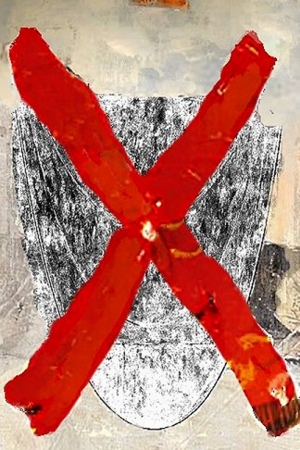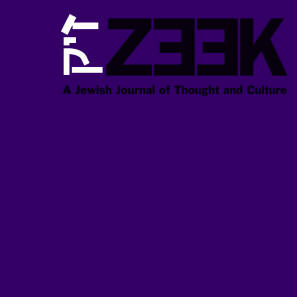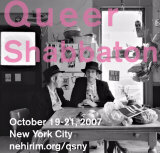 September 07
September 07
Missing A Beat
Mark Cohen
The marketers of Beat sure have learned the lessons of standardization. The year started off with New York’s 92nd Street Y taking a look at Allen Ginsberg and Jack Kerouac, and the salute to these stalwarts will probably continue through September when Viking issues a 50th anniversary edition of On The Road. A New York Post article marched to the same drummer, promoting the Y event and offering a reading list of the Beat brand names Ginsberg, Kerouac, Corso,  Burroughs and Ferlinghetti. An equally predictable cast of characters appears in The Beats: A Literary Reference, The Portable Beat Reader, The Rolling Stone Book of the Beats, and The Beat Book. But none of these collections make room for an offbeat Beat: the bridge-burning, miserably Jewish, self-described failure Seymour Krim.
Burroughs and Ferlinghetti. An equally predictable cast of characters appears in The Beats: A Literary Reference, The Portable Beat Reader, The Rolling Stone Book of the Beats, and The Beat Book. But none of these collections make room for an offbeat Beat: the bridge-burning, miserably Jewish, self-described failure Seymour Krim.
Krim was a cranky, irritable, and direct writer who in the early 1950s wrote well-behaved lit-crit pieces for highbrow publications such as Commentary, Commonweal, and the The Hudson Review. Then he had a mental breakdown, was institutionalized, and upon his return to Greenwich Village started churning out in the pages of the Village Voice and elsewhere the anguished, subjective journalistic pieces that won him notoriety and led to his editing The Beats, a classic 1960 anthology brave enough to include critics alongside adherents. A year later Krim published his own collected writings in Views of a Nearsighted Cannoneer, a slim volume printed on cheap paper that won attention with its unleashed voice, smartass title, and a foreword by Norman Mailer. James Baldwin called Cannoneer an “extraordinary volume,” and he praised Krim’s essay on New York’s 1950s intellectual scene as “the most candid and truthful record of that time that I have ever read.” That essay, “What’s This Cat’s Story?,” also passed muster with Saul Bellow, who published it in his journal, The Noble Savage, to coincide with the release of Cannoneer. Mailer’s laudatory foreword gave Krim an impressive critical trifecta. According to Mailer, Krim’s writing “has the guts of New York,” and that future historians “will say if they have a sense of the past that yes, in the work of Seymour Krim lives one of the truest beats of how horrible, how jarring, how livid and how exciting was this city.”
What Mailer had in mind was writing such as Krim’s “Making It,” which captured the birth of celebrity culture in the art-tinged and money-mad world of post-war New York:
When has an inside phrase like 'making it' or so-and-so's 'got it made' shot with such reality through the museum of official English? In this terse verbal shorthand lies a philosophy of life that puts a gun in the back of Chase Manhattan rhetoric and opens up, like a money-bag, the true values that make the Sammys and Susies of modern city life run today. You've got it made. How the words sing a swift jazz poem of success, hi-fi, the best chicks (or guys), your name in lights, pot to burn, jets to L.A. and London, bread in the bank, baby, and a fortress built around your ego like a magic suit of armor!
It was one of Krim’s gifts to write angry without becoming a scold. He was titillated even as he held his nose. A neat trick.
Krim didn’t live to see the revival of his reputation that Mailer predicted. He died in 1989 at age 67, and in the nearly 20 years since then the work of future historians has only gotten harder. Though Phillip Lopate included Krim in The Art of the Personal Essay, an anthology that put the writer in the company of Plutarch, Thoreau, Orwell and other luminaries, and Dan Wakefield’s landmark New York in the 50s saluted his “jazzy, electric prose,” editors have left Krim out of most Beat collections.
They may be on to something. Krim always had a hard time fitting into categories and had a knack for saying the thing no one wanted to hear. Incarceration in mental hospitals strengthened his conviction that kowtowing to acceptable standards was a spiritual dead-end and he returned to the streets apparently fearless. In a 1959 essay called “The Insanity Bit,” he attacked Beat gospel when he called the legendary opening line of Ginsberg’s Ginsberg%2Fdp%2F0060926112&tag=zeek-20&linkCode=ur2&camp=1789&creative=9325 target=new >Howl – “I saw the best minds of my generation destroyed by madness” – “lurid sentimentalism.” Not the kind of talk designed to win friends and influence people in the Village. But Krim felt that the “pathological interpretation of human nature has become a style in our period.” His manifesto for a different life plan urged readers to reject fashion and instead “to trust implicitly what they see with their intellect and imagination; for when the climate changes, only the individual vision will stand secure.”
Krim put his trust in his own imagination and intellect and came up with an individual vision that consistently went against the grain. In 1957, Mailer’s essay “The White Negro” praised and romanticized Black anger and even Black violence. That same year Krim looked back on his own youthful infatuation with Harlem and drew different conclusions. In “Anti-Jazz: Unless the Implications are Faced,” he warned white hipsters that the Black jazz music and cool style they love stem from a “wild, violent, bitterly unjust life” that should not be emulated. The article appeared in the Voice and hit its readers where they lived:
These people, the white jazz-lovers, hear only the extract of the kind of life that produced this music; its sensuality, rhythm, humor, passion, even closeness and intimacy. It is especially attractive to young people who are disillusioned with the values of white society. But no matter how beat they are themselves, the majority have literally no idea of the conditions of life that lie behind this music.
“Anti-Jazz” generated a backlash that in retrospect seems like an early attack by the politically correct, and Krim was forced to rethink and ultimately defend his views in a companion piece called “Ask for a White Cadillac” that joined “Anti-Jazz” in Cannoneer. James Baldwin applauded both articles. Baldwin wrote that “Anti-Jazz” ought to be “required reading by every hipster” and that Krim is, “God bless him, almost the only writer of my generation who has managed to release himself from the necessity of being either romantic or defensive about Negroes.”
Beyond Universalism
As one critic recognized, Krim’s “deeply personal” writings were meant to create “a representative self that can serve as the basis for an acute examination of contemporary American life.” It is an approach “strongly influenced by the Beats, emphasizing the centrality of the self.” It is also classically American, with Krim, Ginsberg and others pointing to Walt Whitman as their inspiration. Whitman’s was the primordial representative self that embraced a universal view of a common humanity – “What I assume you shall assume.”
This universalism suited Krim up to a point, but it couldn’t accommodate the fact that he was a Jew. Krim knew in his bones that Jewish identity and history couldn’t be glossed over and subsumed under a general human category. It had to be explicitly named and examined, and in a number of essays he stepped forward as a representative Jewish self and reworked Whitman’s confident banner into moody angry comic invective that might be summarized, “My anxiety is your anxiety.”
The Jewish topic is there from the beginning. In “Ask for a White Cadillac,” his follow-up to “Anti-Jazz” that explores how whites perceive Black culture, Krim saw that there was a Jewish variant to the general condition. Today the study of the Black-Jewish cultural nexus is so robust one critic called it an industry, but in 1959 it resembled a mom-and-pop shop. Krim had a part-time job there. He saw that his youthful admiration for Black life grew from a “defiant liberalism and sense of identification stemming in part from my being the unreligious modern American Jew who feels only the self-pitying sting of his identity without the faith.”
He made much more of the Jewish angle in the 1960 “What’s This Cat’s Story?” which first appeared in Bellow’s Noble Savage. The essay recounts Krim’s marginal membership in the New York intellectual world, and it focuses on the Jewish ingredient that served many as an angry engine powering insight, originality, and cleverness. The essay was decades ahead of today’s cultural criticism, which freely investigates how the problems and perspectives offered by Jewish identity shape Jewish and American life, from Broadway to Barbie. Krim knew he was treading on new ground and he was nervous but determined:
I now come to an unpopular topic but one that has to be opened up. Most of my friends and I were Jewish; we were also literary; the combination of the Jewish intellectual tradition and the sensibility needed to be a writer created in my circle the most potent and incredible intellectual-literary ambition
I have ever seen. Within themselves, just as people, my friends were often tortured and unappeasably bitter about being the offspring of this unhappily unique-ingrown-screwed-up breed…. I may be reducing the many causes for this terrible display of intellectual egomania to a too-simple basic source – for surely the overworshipped genius-standards of the literary climate as a whole goosed the entire phenomenon – but if I can generalize on the basis of my own experience it was the ceaseless knowledge of knowing you could never erase this brand of being that drove us mentally upward without rest.
Krim saw that many Jews experienced Jewish identity as a “blotch of birth” they hoped “brilliant individualism” would help them transcend. His insight was born of a failure to do the same. When it came to Jewish identity, it was Krim’s fate to descend, not transcend. In a 1969 article about Norman Mailer for New York magazine, the weekly that helped launch the New Journalism, Krim recognized with awe and envy that Mailer “had crashed out of the parochial” Jewish world “into the splendid chaos of everyone’s U.S.A.” Krim vowed to do likewise. He too would hit the big-time with writing that would tap rich American themes and accumulate a vast public. This never happened. Despite himself, he kept trudging down into unglamorous Jewish trenches to investigate the topics he was born into and could not abandon: Jewish self-hatred; anti-Semitism; post-Holocaust Jewish anger; the loss of an authentic Jewish identity and nourishing culture; the enfeebling Jewish hunger for cultural respectability and also its flipside: the commonplaces of Jewish bohemianism. Like a renegade archeologist determined to dig in unpromising ground, Krim descended into the ruins of his Jewish identity and wrote about what he found there.









